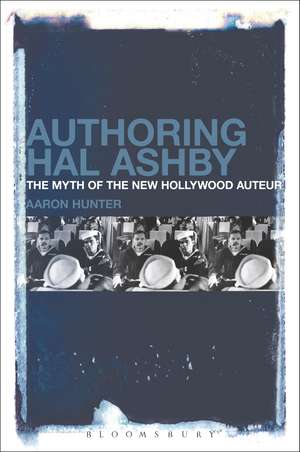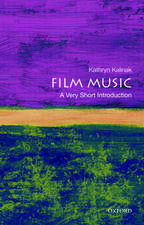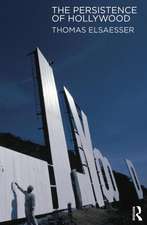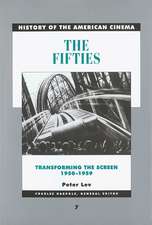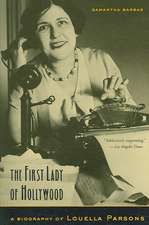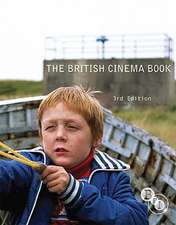Authoring Hal Ashby: The Myth of the New Hollywood Auteur
Autor Dr. Aaron Hunteren Limba Engleză Paperback – 21 feb 2018
| Toate formatele și edițiile | Preț | Express |
|---|---|---|
| Paperback (1) | 236.74 lei 6-8 săpt. | |
| Bloomsbury Publishing – 21 feb 2018 | 236.74 lei 6-8 săpt. | |
| Hardback (1) | 776.65 lei 6-8 săpt. | |
| Bloomsbury Publishing – 24 aug 2016 | 776.65 lei 6-8 săpt. |
Preț: 236.74 lei
Preț vechi: 305.22 lei
-22% Nou
Puncte Express: 355
Preț estimativ în valută:
45.30€ • 48.44$ • 37.77£
45.30€ • 48.44$ • 37.77£
Carte tipărită la comandă
Livrare economică 17 aprilie-01 mai
Preluare comenzi: 021 569.72.76
Specificații
ISBN-13: 9781501340192
ISBN-10: 1501340190
Pagini: 240
Ilustrații: 12 bw illus
Dimensiuni: 152 x 229 mm
Greutate: 0.31 kg
Ediția:NIPPOD
Editura: Bloomsbury Publishing
Colecția Bloomsbury Academic
Locul publicării:New York, United States
ISBN-10: 1501340190
Pagini: 240
Ilustrații: 12 bw illus
Dimensiuni: 152 x 229 mm
Greutate: 0.31 kg
Ediția:NIPPOD
Editura: Bloomsbury Publishing
Colecția Bloomsbury Academic
Locul publicării:New York, United States
Caracteristici
Contains one of the first practical applications of a multiple-authorship approach to formal and stylistic analysis
Notă biografică
Aaron Hunter lectures in the Department of Media Studies at Maynooth University in Ireland. His interests include authorship in film and television, sound and music in film, and Hungarian cinema. His articles have appeared in Alphaville and the Journal of Film and Video.
Cuprins
Introduction Part One History, Historiography, and Hal Ashby's Reputation Chapter One Hal Ashby and the New Hollywood Establishment Chapter Two Auteurs and the New Hollywood Canon Part Two Tracing Ashby's Authorship Chapter Three Authorship, Narrative, Themes Chapter Four Authorship, Form, Style Part Three Multiple-Authorship Chapter Five Being There: A Case Study Final Thoughts Re-thinking New Hollywood as a Cinema of Multiple-Authorship
Recenzii
A very useful and lucid contribution to understanding of the films of Hal Ashby and the New Hollywood context in which they are situated. Makes a strong and valuable case for the benefits of an approach that acknowledges multiple contributions to authorship, both in this case and as a way of revisiting the films of the period more generally.
In this extremely well researched and engagingly written study, Aaron Hunter performs a difficult balancing act. He challenges many of the foundational assumptions of Film Studies to do with directorial authorship, the evaluation of films, and canon formation. At the same time, he makes a strong case for the importance of one particular director, offering a wonderfully perceptive, complex analysis of his collaborative working methods and of the stylistic characteristics and thematic concerns of his films. He thus challenges us to reconsider not only Hal Ashby's work and status, but also our preconceptions about the New Hollywood and indeed our understanding of Film Studies as an academic discipline.
With Authoring Hal Ashby: The Myth of the New Hollywood Auteur, Aaron Hunter provides an outstanding contribution to the nascent field of collective authorship studies of film. Combining archival research, interviews, and insightful film analyses, Hunter untangles the complex web of collaborative contributions in films directed by Hal Ashby. In doing so he achieves in this highly readable, thorough, and engaging work much more than an account of an overlooked director and his collaborative approach to film production. He demonstrates that auteur criticism of New Hollywood has mystified our understandings of both New Hollywood directors and the period itself. By tracing the contributions of key production crew to Ashby's films, Hunter gives compelling cause for film scholars to reconsider New Hollywood through the lens of multiple authorship.
In this impeccably-researched volume, Aaron Hunter makes a compelling case for reevaluating one of New Hollywood's neglected auteurs, changing as a result the way we look at film history. It is a pleasure to read and a timely return to some of the 1970s most important and enjoyable films.
Authoring Hal Ashby offers a fresh approach to understanding films of the seventies, which Hunter sees as a period not of directorial dominance but collaboration. The book shows how Ashby's unorthodox approach to filmmaking produced an assortment of intriguing films.
In this extremely well researched and engagingly written study, Aaron Hunter performs a difficult balancing act. He challenges many of the foundational assumptions of Film Studies to do with directorial authorship, the evaluation of films, and canon formation. At the same time, he makes a strong case for the importance of one particular director, offering a wonderfully perceptive, complex analysis of his collaborative working methods and of the stylistic characteristics and thematic concerns of his films. He thus challenges us to reconsider not only Hal Ashby's work and status, but also our preconceptions about the New Hollywood and indeed our understanding of Film Studies as an academic discipline.
With Authoring Hal Ashby: The Myth of the New Hollywood Auteur, Aaron Hunter provides an outstanding contribution to the nascent field of collective authorship studies of film. Combining archival research, interviews, and insightful film analyses, Hunter untangles the complex web of collaborative contributions in films directed by Hal Ashby. In doing so he achieves in this highly readable, thorough, and engaging work much more than an account of an overlooked director and his collaborative approach to film production. He demonstrates that auteur criticism of New Hollywood has mystified our understandings of both New Hollywood directors and the period itself. By tracing the contributions of key production crew to Ashby's films, Hunter gives compelling cause for film scholars to reconsider New Hollywood through the lens of multiple authorship.
In this impeccably-researched volume, Aaron Hunter makes a compelling case for reevaluating one of New Hollywood's neglected auteurs, changing as a result the way we look at film history. It is a pleasure to read and a timely return to some of the 1970s most important and enjoyable films.
Authoring Hal Ashby offers a fresh approach to understanding films of the seventies, which Hunter sees as a period not of directorial dominance but collaboration. The book shows how Ashby's unorthodox approach to filmmaking produced an assortment of intriguing films.
